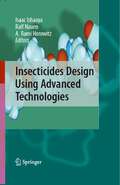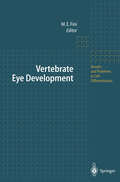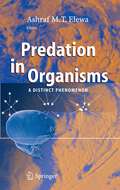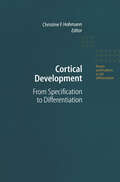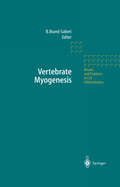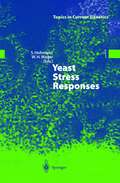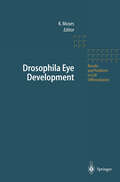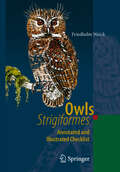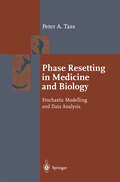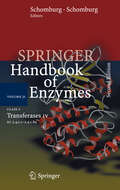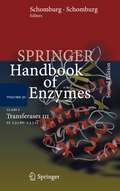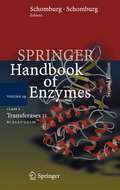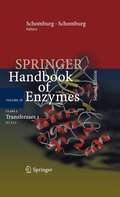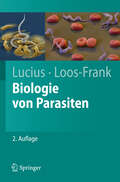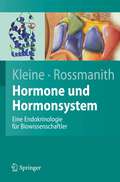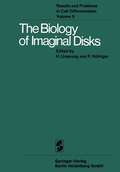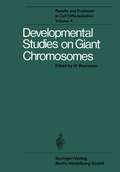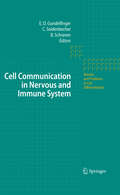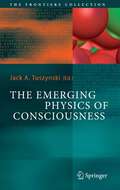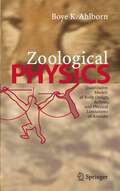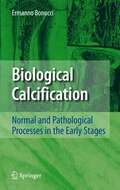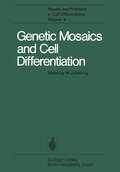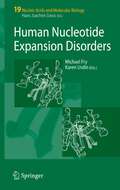- Table View
- List View
Insecticides Design Using Advanced Technologies
by Isaac Ishaaya Ralf Nauen A. Rami HorowitzAmong the highlights of this book are the use of nanotechnology to increase potency of available insecticides, the use of genetic engineering techniques for controlling insect pests, the development of novel insecticides that bind to unique biochemical receptors, the exploration of natural products as a source for environmentally acceptable insecticides, and the use of insect genomics and cell lines for determining biological and biochemical modes of action of new insecticides.
Vertebrate Eye Development (Results and Problems in Cell Differentiation #31)
by M. Elizabeth Fini"Who would believe that so small a space could contain the images of all the universe?" Leonardo da Vinci The last years of the 20th century have found the discipline of Developmental Biology returning to its original position at the forefront of biological re search. This progress can be attributed to the burgeoning knowledge base on molecules and gene families, and to the power of the molecular genetic ap proach. Topping the list of organ systems which have provided the most significant advances would have to be the eye. The vertebrate eye was one of the classic embryologic models, used to demonstrate many important prin ciples, including the concepts of inductive tissue interactions first put forth in the early 1900s. Within the last decade of this century, a return to some of the old questions with the new approaches has put eye development back into the limelight. I find this a highly appropriate topic for a book which aims to spark research for the new millennium. We begin with a chapter that discusses the anatomy of eye development, providing the basic reference information for the chapters that follow. A novel aspect of this introduction is the connection made between develop mental strategies and the eye's optical function. What also emerges from this chapter is the number of important eye structures that have barely been touched by the modern developmental biologist. Work on cornea and ante rior chamber development has lagged behind lens and retina.
Predation in Organisms: A Distinct Phenomenon
by Ashraf M. T. ElewaPredation is considered one of the distinct phenomena related to the interrelationships between species on the Earth. In general, predation is widespread not only in wildlife but also in marine environments where big fishes eat small fishes and other organisms of the sea. This book considers predation in organisms and is aimed at the prevention of predation in wildlife and marine environments.
Cortical Development: From Specification to Differentiation (Results and Problems in Cell Differentiation #39)
by ChristineHohmannThe cerebral neo cortex, unique to mammals, is regarded as the prerequisite for higher cognitive function and is the structure most closely associated with the idea of the "mind" . Expansion of mental capa city between mammals is most typically associated with an evolutionary increase in neocortical volume that culminates in the intricately folded configuration of sulci and gyri so charac teristic of the primate cerebral cortex. Yet, the basic unit structure and funda mental connectivity of cortex appears to have been preserved from the smooth cortex of the mouse or rat to the highly convoluted cortical mantle of the human that, if stretched out as a sheet, would be large enough to wrap the entire human brain multiple times. The basic similarity in structure and func tion has made it possible to conduct studies in the relatively simple cortices of rat or mouse and have the results pertain to the understanding of the primate, including human, cortex. The neo cortex is an intriguing structure for the study of cell differentiation. Its dozens of neuronal cell types and small handful of different glial types have their origin in a pseudostratified germinal epithelium lining the ventricular surface of the forebrain. In its mature form, neocortex is a six-Iayered struc ture; five of its layers contain multiple different but characteristic neuronal types with the sixth occupied by neuronal processes. Various glial cells are dis persed throughout all six layers.
Yeast Stress Responses (Topics in Current Genetics #1)
by Stefan Hohmann Willem H. MagerEvery cell has developed mechanisms to respond to changes in its environment and to adapt its growth and metabolism to unfavorable conditions. The unicellular eukaryote yeast has long proven as a particularly useful model system for the analysis of cellular stress responses, and the completion of the yeast genome sequence has only added to its powerThis volume comprehensively reviews both the basic features of the yeast genral stress response and the specific adapations to different stress types (nutrient depletion, osmotic and heat shock as well as salt and oxidative stress). It includes the latest findings in the field and discusses the implications for the analysis of stress response mechanisms in higher eukaryotes as well.
Drosophila Eye Development (Results and Problems in Cell Differentiation #37)
by KevinMoses1 Kevin Moses It is now 25 years since the study of the development of the compound eye in Drosophila really began with a classic paper (Ready et al. 1976). In 1864, August Weismann published a monograph on the development of Diptera and included some beautiful drawings of the developing imaginal discs (Weismann 1864). One of these is the first description of the third instar eye disc in which Weismann drew a vertical line separating a posterior domain that included a regular pattern of clustered cells from an anterior domain without such a pattern. Weismann suggested that these clusters were the precursors of the adult ommatidia and that the line marks the anterior edge of the eye. In his first suggestion he was absolutely correct - in his second he was wrong. The vertical line shown was not the anterior edge of the eye, but the anterior edge of a moving wave of patterning and cell type specification that 112 years later (1976) Ready, Hansen and Benzer would name the "morphogenetic furrow". While it is too late to hear from August Weismann, it is a particular pleasure to be able to include a chapter in this Volume from the first author of that 1976 paper: Don Ready! These past 25 years have seen an astonishing explosion in the study of the fly eye (see Fig.
Processes with Long-Range Correlations: Theory and Applications (Lecture Notes in Physics #621)
by Govindan Rangarajan Mingzhou DingProcesses with long range correlations occur in a wide variety of fields ranging from physics and biology to economics and finance. This book, suitable for both graduate students and specialists, brings the reader up to date on this rapidly developing field. A distinguished group of experts have been brought together to provide a comprehensive and well-balanced account of basic notions and recent developments. The book is divided into two parts. The first part deals with theoretical developments in the area. The second part comprises chapters dealing primarily with three major areas of application: anomalous diffusion, economics and finance, and biology (especially neuroscience).
Owls (Strigiformes): Annotated and Illustrated Checklist
by Friedhelm WeickThis is the first systematic owl checklist for over 50 years to include subspecies and synonyms. The book provides information on the type, locality, habitat and distribution of 220 owl species and 539 taxa, as well as the location of museum collections of skins and mounted specimens, and references to owl illustrations. In addition to scientific names, the common names of each species in English, German, French and Spanish are listed. The checklist is complemented by many beautiful owl drawings and by watercolours illustrating owl species that have been newly described or rediscovered within the last 20 years.
Phase Resetting in Medicine and Biology: Stochastic Modelling and Data Analysis (Springer Series in Synergetics)
by Peter A. TassThis book presents a new theoretical approach to phase resetting and stimulation-induced synchronization and desynchronization in a population of oscillators. The author uses stochastic methods from statistical mechanics and applies his theory to models of practical importance in physiology and neuroscience. The book is accessible to readers not familiar with the mathematical formalism. The author also proposes improvements to stimulation techniques as used by neurologists and neurosurgeons in the context of Parkinson's disease and MEG/EEG data analysis.
Class 2 Transferases IV: EC 2.4.1.1 - 2.4.1.89 (Springer Handbook of Enzymes #31)
by A. ChangThe Springer Handbook of Enzymes provides concise data on some 5,000 enzymes sufficiently well characterized – and here is the second, updated edition. Their application in analytical, synthetic and biotechnology processes as well as in food industry, and for medicinal treatments is added. Data sheets are arranged in their EC-Number sequence. The new edition reflects considerable progress in enzymology: the total material has more than doubled, and the complete 2nd edition consists of 39 volumes plus Synonym Index. Starting in 2009, all newly classified enzymes are treated in Supplement Volumes.
Class 2 Transferases III: EC 2.3.1.60 - 2.3.3.15 (Springer Handbook of Enzymes #30)
by Antje ChangThe Springer Handbook of Enzymes provides concise data on some 5,000 enzymes sufficiently well characterized – and here is the second, updated edition. Their application in analytical, synthetic and biotechnology processes as well as in food industry, and for medicinal treatments is added. Data sheets are arranged in their EC-Number sequence. The new edition reflects considerable progress in enzymology: the total material has more than doubled, and the complete 2nd edition consists of 39 volumes plus Synonym Index. Starting in 2009, all newly classified enzymes are treated in Supplement Volumes.
Class 2 Transferases II: EC 2.1.2.1 - 2.3.1.59 (Springer Handbook of Enzymes #29)
by A. ChangThe Springer Handbook of Enzymes provides concise data on some 5,000 enzymes sufficiently well characterized – and here is the second, updated edition. Their application in analytical, synthetic and biotechnology processes as well as in food industry, and for medicinal treatments is added. Data sheets are arranged in their EC-Number sequence. The new edition reflects considerable progress in enzymology: the total material has more than doubled, and the complete 2nd edition consists of 39 volumes plus Synonym Index. Starting in 2009, all newly classified enzymes are treated in Supplement Volumes.
Class 2 Transferases I: EC 2.1.1 (Springer Handbook of Enzymes #28)
by Antje ChangThe Springer Handbook of Enzymes provides concise data on some 5,000 enzymes sufficiently well characterized – and here is the second, updated edition. Their application in analytical, synthetic and biotechnology processes as well as in food industry, and for medicinal treatments is added. Data sheets are arranged in their EC-Number sequence. The new edition reflects considerable progress in enzymology: the total material has more than doubled, and the complete 2nd edition consists of 39 volumes plus Synonym Index. Starting in 2009, all newly classified enzymes are treated in Supplement Volumes.
Biologie von Parasiten (Springer-Lehrbuch)
by Richard Lucius Brigitte Loos-FrankInfektionserreger der besonderen Art: Malaria, Schlafkrankheit, Würmer und Zecken. Die Autoren bieten auf Grundlage der aktuellen Systematik eine Übersicht über die Biologie parasitärer Einzeller, Würmer und Arthropoden. In Querschnittskapiteln sprechen sie die Besonderheiten der parasitischen Lebensweise an. Am Beispiel typischer Vertreter stellen sie die Lebenskreisläufe und immunologische sowie molekulare Aspekte dar. Sie behandeln sowohl die Krankheiten der Tiere als auch die des Menschen. Anschauliche Abbildungen ergänzen den Text. Eine weitere wertvolle Ergänzung sind die klinischen Bilder der Krankheiten sowie Prüfungsfragen am Ende eines jeden Kapitels. Mit diesem Lehrbuch sind Sie gut gerüstet!
Hormone und Hormonsystem: Lehrbuch der Endokrinologie (Springer-Lehrbuch)
by Bernhard Kleine Winfried RossmanithHormone steuern die Balance! Sie regulieren die Physiologie: Wasser- und Salzhaushalt, Blutdruck, Nahrungsaufnahme, Blutzucker und Stressreaktion. Hormone ermöglichen die Fortpflanzung. Sie werden ausgeschüttet, wenn wir verliebt sind oder wenn wir pubertieren. Wo Knochen wachsen, sind sie beteiligt. Hormone und deren Biosynthese, dazu die entsprechenden Rezeptoren und endokrinen Organe. Die Hormonphysiologie steht dabei im Mittelpunkt. Besonders spannend: das Thema der hormonellen Evolution. Anhand klinischer Defekte wird das Ausmaß hormoneller Einflüsse deutlich. Aktuell: Doping. Diese Einführung ist Ihr Schlüssel zu mehr Selbstverständnis!
The Biology of Imaginal Disks (Results and Problems in Cell Differentiation #5)
by H. Ursprung R. Nöthiger~o working hypothesis amounts to much until it has been tested on suitable material. Indeed, the choice of an appropriate experimental system has often been the key to the solution of a problem. The present volume is devoted to insect imaginal disks. These groups of larval cells are the primordia of precisely characterized adult counterparts, without apparent function in larvae. At the onset of metamorphosis, the subtle interplay of hormonal signals brings growth to a halt, and differentiation begins. In the fruitfly, a host of mutations are known to affect the development of disks; these provide ample material for analysis. It was largely ERNST HADORN'S ingenuity that directed the attention of many scientists around the world to this promising experimental system, and to him this volume is dedicated. All the contributors have been associated with him at one time or another, as graduate students, postdoctoral fellows, or colleagues. Each author has attempted to cover comprehensively the topic assigned to him. This has inevitably led to some overlapping, for which the editors should be blamed, not the authors, as this results from the way the topic was subdivided at the outset. We believe this volume will be a welcome sourcebook for the specialist in the field, and a provocative monograph for the uninitiated scientist interested in the exciting area of cell determination.
Developmental Studies on Giant Chromosomes (Results and Problems in Cell Differentiation #4)
by W. BeermannEarlier titles in this series have directed attention to selected questions of current theoretical or practical interest in developmental biology, without special emphasis upon individual biological systems. Tho choose giant polytene chromosomes as the common denominator of a new volume may at first sight seem to set rather arbitrary restrictions upon a coherent discussion of the basic problem of cellular differentiation. However, the reader will find out for hirnself that, on the contrary, such a limitation, though dicta ted by the material, focuses the analysis upon one essential point: the differential release of genetic information from operational subunits of the eukaryotic chromosome. In the organization of this volume we have not striven for completeness - some, indeed, may fee 1 that the work on Sciarids is underrepresented - but the various contributors have made every effort to render a thorough and up-to-date picture of the situation in their particular field, and on this basis to discuss all possible angles of general biological interest. Authors and editors have agreed to dedicate this volume to the memory of JACK SCHULTZ.
Cell Communication in Nervous and Immune System (Results and Problems in Cell Differentiation #43)
by Eckart D. Gundelfinger Constanze Seidenbecher Burkhart SchravenThis collection of reviews contains contributions by internationally recognized immunologists and molecular and cellular neurobiologists. Uniquely, it puts side by side cellular communication devices and signaling mechanisms in the immune and nervous systems and discusses mechanisms of interaction between the two systems, the significance of which has only recently been fully appreciated.
The Emerging Physics of Consciousness (The Frontiers Collection)
by Jack A. TuszynskiSeeks answers to these questions using the underlying assumption that consciousness can be understood using the intellectual potential of modern physics and other sciences. There are a number of theories of consciousness, some based on classical physics while others require the use of quantum concepts. The latter ones have drawn criticism from the parts of the scientific establishment while simultaneously claiming that classical approaches are doomed to failure. The contributing authors presents a spectrum of opinions from both sides of this on-going scientific debate, allowing readers to decide for themselves which of the approaches are most likely to succeed.
Zoological Physics: Quantitative Models of Body Design, Actions, and Physical Limitations of Animals
by Boye K. AhlbornThis book presents a physicists view of life. The primary life functions of animals, such as eating, growing, reproducing and getting around all depend on motion: Motion of materials through the body, motion of limbs and motion of the entire body through water, air and on land. These activities are driven by internal information stored in the genes or in the brain and by external information transmitted by the senses. This book models these life functions with the tools of physics. It will appeal to all scientists, from the undergraduate level upwards, who are interested in the role played by physics in the animal kingdom.
Biological Calcification: Normal and Pathological Processes in the Early Stages
by Ermanno BonucciFor the first time, this book offers a critical review of the calcification process of the organic and inorganic phases of mineralized tissues focusing on the earliest phases. It includes a methodological chapter which provides the necessary practical information for making appropriate choices. The book is set to become an important reference source for the shelves of bone densitometry labs across the world.
Genetic Mosaics and Cell Differentiation (Results and Problems in Cell Differentiation #9)
by W. J. GehringThe relationship of cell lineage and differentiation is one of the most intriguing problems in developmental biology. In most higher organisms, the analysis of the cell lineage has to rely on indirect methods. Only in the most suitable systems, like the nematodes, can the pattern of cell division be determined by direct observation under the microscope. In cases where this is not possible, the fate of the cells has to be examined by using cell markers. Most suitable for this purpose are genetic markers, provided that they do not interfere with the developmental pathway to be studied. However, suitable genetic markers and techniques for generating genetic mosaics are available in a few organisms only. Therefore, this volume is largely concerned with Drosophila and the mouse, which have been studied most extensively. In 1929 STURTEVANT introduced the analysis of gynandromorphs into devel opmental genetics. However, this important contribution remained largely unnoticed until the late sixties, when the potential of this technique for deter mining embryonic fate maps and the number of primordial cells was exploited, and the methodology extended to the mapping of mutational foci. Mitotic recombination was demostrated by STER:-< in 1936, who realized the potential of this technique for the analysis of cell lineage and pattern formation. The usefulness of this method was substantially increased by the discovery of FRIESEN that mitotic recombination can be induced by x-irradiation. This allows the induction of mosaicism at any stage of development.
Methoden der Verhaltensbiologie (Springer-Lehrbuch)
by Marc NaguibMarc Naguib erklärt die grundlegenden Methoden der qualitativen und quantitativen Erfassung von Verhalten. Dabei werden deskriptive und experimentelle Ansätze von Versuchsplänen berücksichtigt. Anhand von Beispielen aus der aktuellen Forschung wird die Breite der modernen verhaltensbiologischen Forschung anschaulich dargestellt.
Human Nucleotide Expansion Disorders (Nucleic Acids and Molecular Biology #19)
by Michael Fry Karen UsdinHuman neurological and neuromuscular disorders caused by nucleotide expansion are the focus of growing interest of practicing physicians and of interested biomedical researchers. This volume represents a comprehensive and up-to-date description of many of the better-studied disorders. The authors discuss molecular, clinical and pathological aspects of the diseases as well as our current understanding of their underlying mechanisms.
